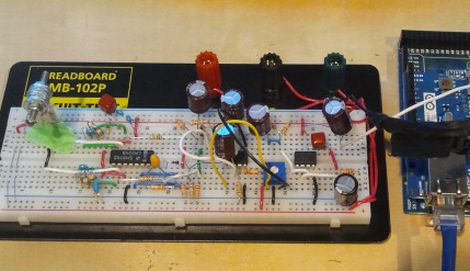While we normally see piezo elements being used to output audio, [Veedo] thought that they could be used in a more useful manner. He bought way too many piezo film tabs and decided to use them to build a makeshift seismic sensor.
The piezo tabs came with weights attached at one end, though while testing them, he found that they more or less only detected vibrations with frequencies in the KHz range. Since earthquakes tend to produce vibrations in the 30-80 Hz range, he had to tweak his setup to detect the proper frequencies. To do this, he attached a weight made of a screw and washers, checking the output signals on his oscilloscope until the dominant sensed frequencies were in the range of 40 Hz.
The sensor was attached to a breadboard, then wired through a charge amp to create a small AC signal, which floats on 2.5Vdc. The bottom half of the wave is chopped off with a diode, after which it is fed into an Arduino Mega. The seismic data is then pushed up to his Pachube account for storage, though he can view the feeds locally via the a web server programmed into the Arduino.
We’re not sure how much advanced notice this sort of setup would give you in the event of an earthquake, but it seems like a fun project to build either way.















lets hope he hasn’t got wood flooring!
Earthquakes are a lot lower frequency.
Peak acceleration in the epicentral region is under 10 Hz.
cf. Figure 10.10, p 500
Quantitative Seismology
Aki & Richards
Can you please tell me the different frequencies of earthquake or give me a link to any useful article to it.I am working on Earthquake early warning system using wireless sensor nodes.
Regards
For the same intent I’m collecting those piezo modules from electric lighters. If tapped with a finger, a contemporary high-impedance VOM already shows a few volts. The hard part seems to be mechanical. I intuitively understand that the weight must be able to freely oscillate, and a certain amount of damping is needed to flatten the resonance curve. As in the textbooks, the resonance frequency \omega = sqrt(k / m).
A voice coil ensures more displacement. Damping could be adjusted by loading it with a resistor. Perhaps an entire bass speaker, after a mass is affixed to the center, would make a nice 1-axis seismometer. But they are expensive.
A piezo, though, has no elastic elements and so exhibits virtually no displacement (k is very large). After stiff coupling to a weight the resonance frequency will be high. A mass that ensures a low enough \omega might be infeasibly large, and almost a short-circuit might be needed for damping.
Therefore I’m currently planning two compression springs at opposite sides of the weight. A piezo could then be placed between one of the springs and its support. However, despite the fact that I’m addicted to salvaging electronic components and small mechanical parts, my collection of springs is still too small :/
There was an article I read years ago in one of the editions of “The Engineer’s Mini Notebook” by Forest M. Mims that described a similar setup using a permanent magnet suspended in a long tube (affixed to the floor) and in close proximity to a telephone voice pickup (from an old handset phone). Simple op-amp provided the amplification.
I’ve not been able to find the article for some time however..
Something like this one?
http://njsas.org/projects/tidal_forces/01/baker/index.html
I remembered that article as well and still happen to have a copy. Pages 40-41 of the Science Projects min-notebook, RS # 276-5018. It used two 741 op-amps; a telephone pickup coil or 9-volt relay; three resistors and an LED indicator, or optional piezo buzzer.
What is the effect of attaching weights? (Mechanical noob here)
A weight stores kinetic energy and releases it after the initial force has gone.
Since more weight => more energy needed to move it => more time needed to apply an amount of energy => more time needed to “discharge” the accumulated energy, then the more weight you add, the lower frequency it oscillates.
(you can clearly see the similarity between a weight in mechanics and a capacitor in electronics)
So this is more of a “Boom Car” sensor since it works in the audio range? Would go off all the time in Baltimore…
You know the ultimate goal doesn’t have to be early warning. If the sensors can detect the initial compression vs contraction (not sure if his chopped waveform does this), you could use an array of these to locate the earthquake epicenter and the orientation (in at least two possible planes) of the fault break.
Although they have been documented to be near audible at the epicenter due to attenuation as the travel earthquake waveforms tend to be .5 to 20 Hz depending on the distance.
All said this is cheaper than the 1hz geophones I have. :)
For my thesis i actually used piezo film accelerometers to do a seismic reflection (subsurface imaging) study… Where pretty much all of that “sensor” stuff is built into a small, convenient package.
Dave, Is there any chance of getting a copy of your thesis regarding your post in 2011, “For my thesis i actually used piezo film accelerometers to do a seismic reflection (subsurface imaging) study… Where pretty much all of that “sensor” stuff is built into a small, convenient package.”? i am interested in the design. I would like to make an inexpensive seismic sensor that can determine the depth to shallow bedrock or hard till (5 to 30ft)
The P and S waves are from 0.5 Hz to !0 Hz for local quakes, more distant quakes may be from 0.5 Hz to 2 Hz. The S wave is about 0.46 x the period of the P wave. Surface waves have periods of about 20 seconds.